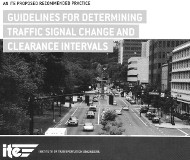3/20/2015
National Standard Heads Toward Longer Yellow TimesInstitute of Transportation Engineers proposal lengthens recommended yellow times by about 0.4 seconds.

Red light camera use has been on the decline nationwide, and the industry's woes are set to worsen. The Institute of Transportation Engineers (ITE) is circulating proposed changes to its yellow signal timing formula that will give motorists more time to stop at intersections without getting a ticket in the mail.
ITE's proposed recommended practice guidelines are used by traffic engineers nationwide to determine how much yellow time is given at intersections. The federal Manual on Uniform Traffic Control Devices recommends the ITE method, and its use is mandatory under state law in Virginia. Following the work of the National Cooperative Highway Research Program (NCHRP), the new ITE proposal recognizes that most local jurisdictions post speed limit signs that are significantly slower than the actual speed of traffic. This throws off the calculation for yellow time, which is based in part on how long it takes for a car to come to a stop.
Cities are supposed to perform a speed study to determine the 85th percentile speed, which is the actual rate that a majority of motorists safely travel on a given road in free-flowing traffic. If they do not perform a proper study, the city must add 7 MPH to the speed limit when calculating the yellow time. In most cases, this will add between 0.3 and 0.4 seconds to the yellow time. The proposal also recommends longer yellows whenever there are too many red light violations.
"When the percentage of vehicles that entered on a red indication exceeds that which is locally acceptable, the yellow change interval may be lengthened until the percentage conforms to desirable standards," the ITE proposal explains.
The trend toward longer yellows represents a change in ITE's stance. At about the same time as US traffic engineers first began experimenting with red light cameras, ITE gradually modified its guidelines so that the yellow time was shortened by about a second from previous standards. The organization steadfastly denied that it was making changes to accommodate red light camera use, an accusation found in a 2001 report by the US House Majority Leader (view report).
Joe Bahen, an ITE member and licensed engineer for the National Motorists Association, thinks the changes do not go nearly far enough to distance ITE from its past. He points out that many jurisdictions underpost speed limits by 12 to 15 MPH, meaning the warning time will still fall too short. NMA had urged ITE to make the "speed limit plus 7 MPH" rule of thumb applicable only for setting timing at new intersections. If red light running is a problem, or red light cameras are used, the group recommended that a formal speed study be made mandatory.
The new ITE proposal also allows the yellow time for left-hand turning lanes to be set by subtracting 5 MPH from the speed limit, resulting in a significantly shorter warning for drivers making a turn. Because those vehicles are decelerating, it takes them 0.5 seconds longer to clear a typical intersection, and, along with other problems with the timing formula, results in a yellow time that is 1.3 seconds too short, according to Bahen's calculations.
"These factors combined make the proposed left-turn yellow much too short for free-flowing vehicles," Bahen explained. "It would undoubtedly cause rear end collisions at camera-enforced intersections."
Bahen is proposing a re-drafting of the proposal so that both straight through and turning movements would have longer yellow times, similar to those in place before red light cameras were used. The proposal does not take effect until it is formally adopted by ITE.
"If ITE wishes to preserve its status as the premier source of rational traffic engineering guidance, the recommended practice must be worded so that local government officials cannot influence or require engineers to set yellow intervals to facilitate red light camera traps," Bahen wrote to fellow ITE members. "To do otherwise would demean our organization and our honorable profession."


